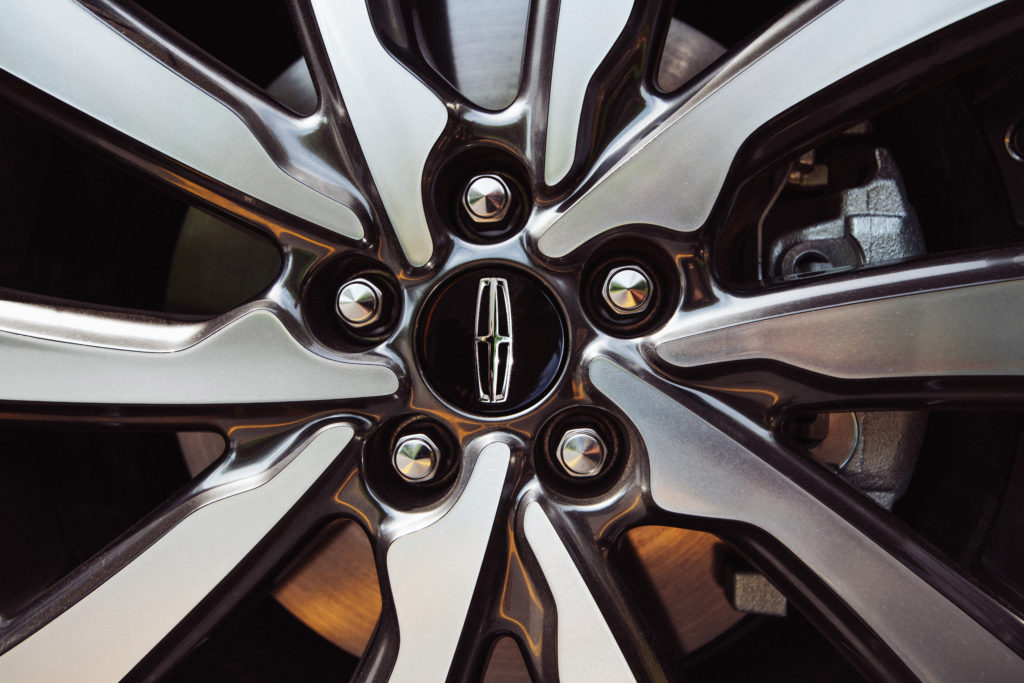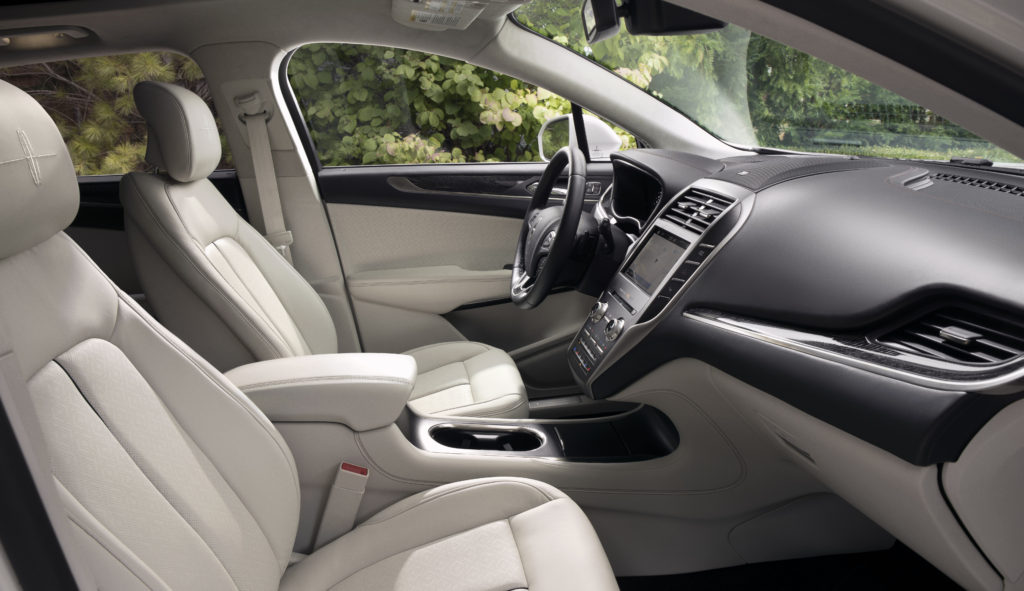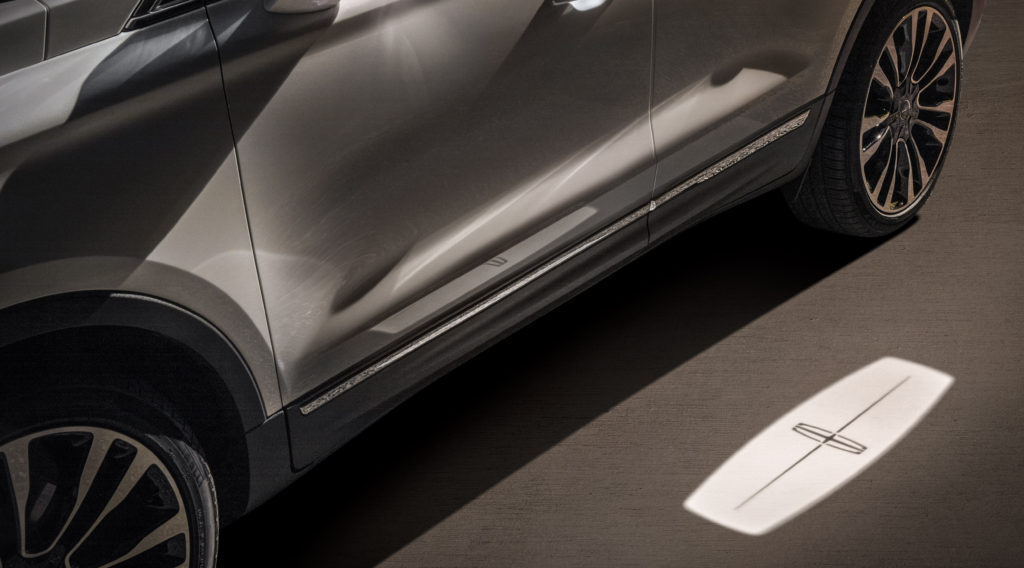Sometimes the best way to understand a vehicle is to compare it to:
- the previous version of that vehicle
- another vehicle in the same automaker’s stable.
Years before I drove the 2019 Lincoln MKC, I tested the 2016 version. And just weeks before, I tooled around in its big sibling, the Navigator. What did I learn? Lincoln has not done much to keep the MKC relevant over the years or distinct in the present. And that’s a good thing.

First impressions
My Baltic Sea Green Metallic tester strikes a sporty pose compared to the Navigator’s imposing one. The “satin chrome mesh” grill fits the MKC just as well, although it leads to lines and scallops that guide the eye along its sides and hood. The whole package rode on 20” machined aluminum wheels that looked just right on the MKC, despite a lowish tire profile for a vehicle this size. The overall look is refreshed but not hugely different from what it was in 2016.

Lincoln’s press materials claim the MKC is most responsible for winning customers away from other luxury brands and that more than half of buyers are women. That’s believable. The wildly successful crossover segment spawned the luxury crossover segment, and given its size and luxury/size/pricing combination, the MKC is designed to score positive attention.
Interior
While not quite as sumptuously outfitted as the Navigator, the MKC is no slouch in the luxury department. Again, much of what’s found here was in the 2016 model.

Exterior LED lighting (including “welcome mats” consisting of Lincoln logos the size of, well, welcome mats) shines to welcome you (and your fob) as you approach the MKC.

Open the door, step over the Lincoln-branded sill, and you’re in a cabin that’s set to coddle both front and rear.
A decidedly more carlike (read: compact) interior than the Navigator’s awaits, although there’s plenty of room for everybody, front and rear, regardless of height. Leather and wood accents mix with other materials, all in different muted colours, to please the eye. Buyers looking for something different may want to check out Lincoln’s Black Label interior themes and the Rialto Green cabin.
Power adjustable front seats may not sport every last setting I foudn in the Navigator, but they proved perfectly comfortable. Controls reside in their usual place – on the door side under the seat cushion – instead of the more convenient Navigator placement, on the door itself.
Power adjustments and ventilation are exclusive to the front seats, but heating is available to the rear as well. Those passengers can also charge their devices using two USB ports between the front seats.
If they have one, drivers ought to leave the panoramic sunroof “uncovered” (i.e. keep the ceiling material from obstructing the glass) so that rear-seat passengers can enjoy the view above them, if they wish.
Hockey bag test
The bag fits longitudinally with plenty of room to spare. The MKC is in the same category of cargo capaciousness as its rivals in the crossover market segment. For good measure, I lowered the rear seats and moved the front passenger seat forward to take old alpine skis (207 cm – yes, they’re old) to a disposal site.
In-cabin technology
The capacitive touchscreen enables access to Lincoln’s SYNC®3 system, though I stuck mostly to the radio and Apple CarPlay ™ (Android Auto ™ is also available) during my time with the MKC. SYNC, which Lincoln shares with sister company Ford, is a great system. Large onscreen “touch areas” combine with a (usually) minimal number of steps to get things done. Certain controls (I’m thinking primarily of the steering wheel heating switch) ought to be physical (levers, buttons, dials).
Need to work on the go? Your passenger can use the MKC as a hotspot to stay connects to the Internet (or browse the web page devoted to the MKC – see below).

Music came from the (optional) enhanced THX II audio system.
The instrument cluster consists of the frames of two analog dials that each contain digital screens, with a third screen in the middle. The driver controls settings on the left side of the cluster using controls under the left thumb. Elements displayed between the two dials are set using controls under the right thumb. Lincoln (and Ford) have had this setup for years and, given the logic behind it, the layout may well last for years longer. It’s one of the simpler interfaces to the increasing number of settings late-model cars feature.
Driving
The MKC features a 2.3L turbocharged I-4 engine driving a 6-speed transmisson that, in turn, propels all four wheels as needed. Power is more than adequate (285 hp and 305 lb-ft. of torque) for quick starts and imble handling, or towing capacity up to 3,000 pounds, depending on your needs. Lincoln also offers a 2.0L turbo that produces 245 hp.
Ride quality and handling is great. But let me vent on certain little details.
Steering-wheel-mounted paddle shifters make little sense in a luxury crossover. (This critique is not unique to Lincoln, by the way.) There’s a disconnect between those shifters and the elegant set of buttons to the left of the touchscreen that control the automatic transmission. These shifters seem de rigueur in many vehicles and, for the life of me I can’t figure out why. They may get used once, twice, maybe so drivers can show passengers how they work, but I can’t picture drivers wanting to use them regularly. The MKC handles shifting so well there’s little point in a driver doing so.
Adaptive cruise control, part of Lincoln’s technology package, offers smooth deceleration and acceleration, but I would have appreciated a system that does not cut out at low speeds. The extra effort to get going from a stop during highway stop-and-go driving is not onerous, but if Lincoln can save Navigator drivers this minor task, why not do so for MKC buyers who opt for its $2,420 technology package?
Getting even further into the weeds, the cruise control speed adjustment buttons both offer “set” as the option for when cruise control has been deactivated but not turned off (i.e. when you brake while driving). The “resume” option is a separate button. This is the best example I can give of where Lincoln (oddly) adds more controls than are strictly necessary. The key reason I’m pointing this out is because it contravenes a norm in manual cruise control speed adjustment that had me puzzled until I took a good look at the switch (why can’t I slow down when I press the “-” part of it?)
Going to something even more basic, the electronic parking brake switch resides under the lighting control cluster, under the dash in front of the driver’s left knee. This makes it difficult to see and obliges the driver to bend forward to use it. Lincoln may want to consider more prominent placement for this most commonly used (I hope) of automotive controls.
The MKC offers modern active safety features like pre-collision assist with pedestrian attention, lane-keeping alert and a blind-spot information system.
Fuel economy
Lincoln publishes cityéhighway estimates of 12.3 and 9.3 L/100 km respectively.
Conclusions
Different from the Navigator, and tweaked and updated since its 2016 incarnation, the MKC ably vies for the luxury crossover buyer’s dollar. Aside from certain odd ergonomic choices that nobody but a cranky automotive reviewer would notice, it has solidly staked out a position as the upscale crossover at a competitive price.
Pricing
Lincoln prices the 2019 MKC AWD at $48,700 MSRP. My tester includes upgrades like the technology package, and those options, plus taxes and other charges, brought the MSRP to $57,870.